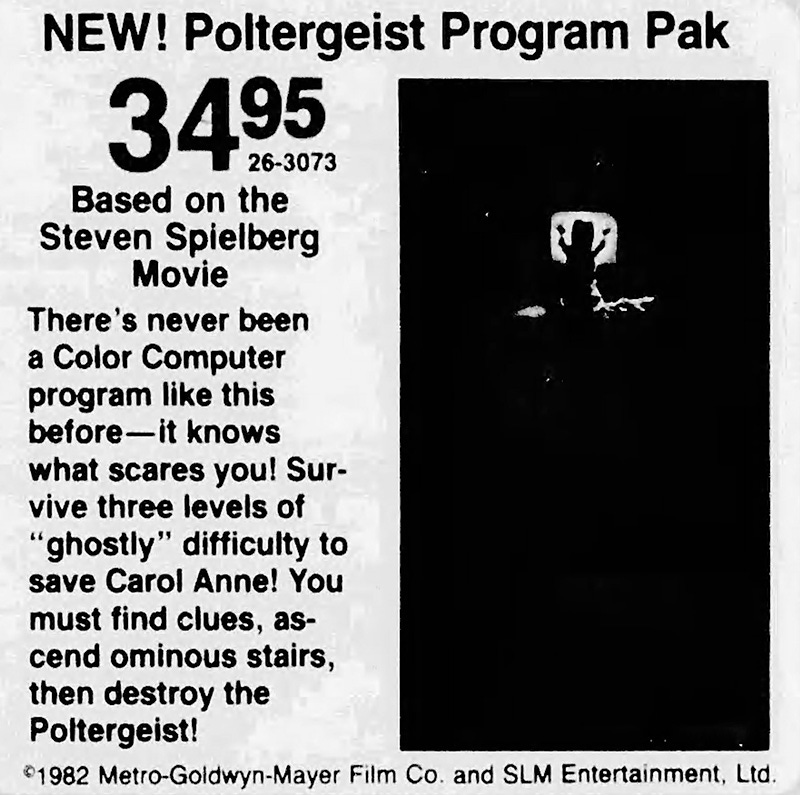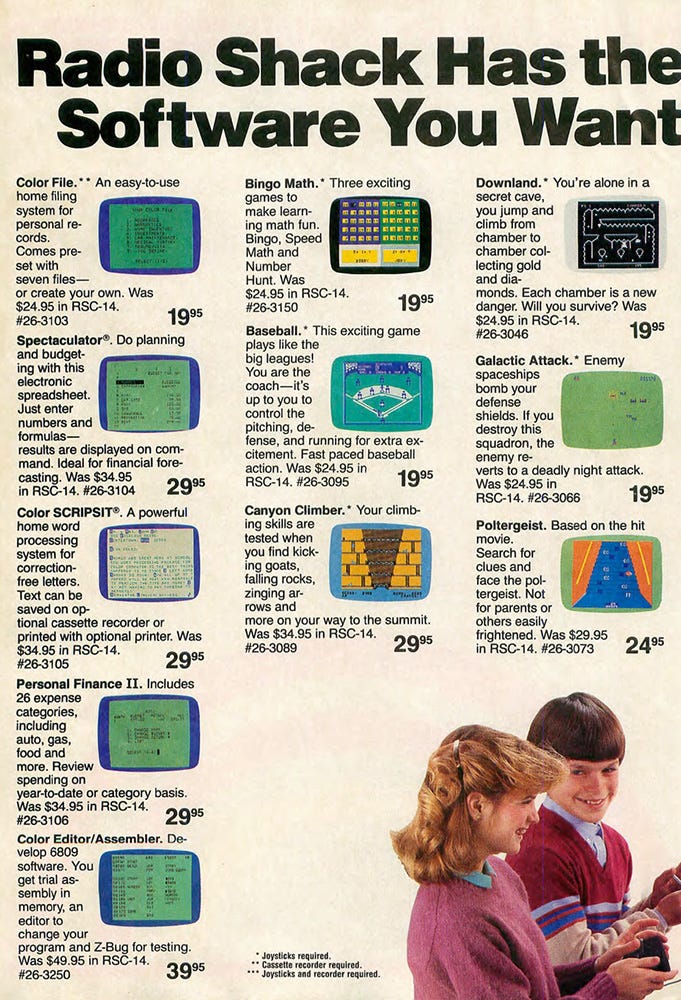Poltergeist for the TRS-80 Color Computer
They're here! And they are exclusive to the TRS-80 Color Computer.
It took me a few years to get a computer in the 1980s, eventually landing a Commodore VIC-20. In the meantime, many of my friends and their families had all sorts of computers. The most popular were various machines from Atari, with a few outliers. All of my memories of these machines revolve around doing what kids loved to do back then, playing games. It was during one of these computer gaming sessions that I got to play a pretty exciting game on the TRS-80 Color Computer (CoCo): Poltergeist.
I had played a few other games on the CoCo before, but when my friend invited me over with the promise of a game based on a horror movie that had electrified the neighborhood, I was there in a flash. While the game I played that day was simple by today’s standards, we found it immersive and very challenging. Not only that, but it was unique to the system. Yes, games with the Poltergeist name were released on other computers like the C64 and ZX Spectrum, but neither was based on the film. So this was, I believe, a CoCo exclusive. Surprisingly, even in the years that followed, and with all the movie sequels, they never developed another video game based on the movie or the franchise.
For those unfamiliar with the film, Poltergeist (1982) was a supernatural horror movie about a suburban family whose home is haunted by restless spirits, culminating in the abduction of their young daughter Carole Anne into a ghostly dimension known as the “Other Side.” It was creepy, emotional, and left a serious impression on anyone who saw it back then, including a lot of kids who probably shouldn't have been seen it (but were lucky to do so).
The game was fairly involved, consisting of three levels. The first level had you running around the neighborhood collecting objects that would be used in rescuing Carole Anne from the “Other Side.” You had to move from house to house—those marked with black dots—while dodging cars. Once you collected all the objects, a moving red dot would appear, indicating the house you needed to reach. It moved pretty quickly, but usually just to a nearby house, so you just needed to stay calm. This level had a timer, described as “30 Units” of time. After a few tries, we never ran out of time. If you’re having trouble, here’s a tip: if you hold down the button when the level is loading, the cars won’t load. It makes it much easier to clear and is good for practice.
The next level is a Frogger-like climb up the stairs to the second floor of the house. It’s pretty busy on that stairwell, so you really need to think about your timing and can’t rely on a lot of lateral motion. After a few games, you’ll get the hang of it and reach the final level. I liked the initial challenge of this level. My one big complaint is that the color choice is just too bright. I imagine that was done to make things easier to see and to contrast with the final level.
This last one is pretty great, but also very challenging. It’s sort of a first-person view, with demons and ghosts coming out of the light toward you. You need to use your joystick to shoot them before they reach you. Unfortunately, and at random, one of these pixelated specters turns out to be Carole Anne. If you shoot her, the game ends immediately and you have to start over. If you avoid shooting her and manage to defeat the menacing demons, you rescue Carole Anne and are rewarded with a final screen that simply says, “This house is clean.” That’s when you high-five your friends and start jumping around the room, until your friend’s father yells at you to settle down because he’s trying to watch golf.
You can see the program pak pictured above, which features the famous movie poster. That image also appeared on the box and in the manual. You can find the manual on the Internet Archive (where you can also emulate the game), and it does a pretty good job explaining how to play. My favorite part, though, something I never read as a kid, is a wonderfully written bit of copy that sets up the gameplay.
Steve and Diane Freeling have lost their youngest child, Carol Anne. Well, they haven't exactly lost her . . . she's somewhere in the Freeling's home, being held captive by the Poltergeist. Although her mother can communicate with her via the static emanating from every television in the house, the situation grows more hopeless each day.
It's up to you to rescue Carol Anne from the monstrous grasp of the poltergeist. To do it, you'll have to gather a few objects needed to help locate her: a length of rope, a ribbon, a towel, some tennis balls, and a handkerchief.
Once you have everything you need, including your courage, you'll have to get past the staircase which seems to forbid your entry into Carol Anne's bedroom. After all, it was from this bedroom that she was kidnapped.
If you're able to get upstairs, you'll have to go into the energy field and do battle with the tricky poltergeist, who is determined to keep Carol Anne forever. Your senses will have to be sharply honed to eliminate the poltergeist!
Can you save Carol Anne from an eternity of nothingness? Are you skilled enough to avoid the obstacles thrown in your path by the unrelenting poltergeist? Are you brave enough to keep on trying, no matter what happens? You could sacrifice your life for the sake of a helpless little girl— are you ready to risk it?
When the game hit stores in late 1982, it was priced at $34.95, which is the equivalent of around $111 today. That’s a lot of money for a game. Three years later, in 1985, they were still selling it, as you can see from this ad in Rainbow Magazine from that August. By then, you could pick up a copy on sale for $24.95. That would be a much more reasonable, though still pretty steep, $73 today.
The graphics on the CoCo weren’t jaw-dropping, but they had their charm. The neighborhood layout was simple and blocky, but easy to read, and the stairwell level had a nice sense of vertical movement, especially for the time. The final level stood out with its eerie flickering light and shadowy figures emerging from the center of the screen, it really did capture a sense of the otherworldly. The sound design was basic but effective, with just enough buzzes and beeps to add tension without overwhelming the gameplay. You kind of had to use your imagination to fill in the gaps, but that was part of the magic.
I am still surprised that this turned out to be a title exclusive to the CoCo. While Spielberg was not the director of Poltergeist, I remember even then, they made a big deal about his association with it. This game could have easily been remade to other systems, or at least a derivative of it could have. Maybe it was an issue or licensing or maybe since Poltergeist was released only a week apart from the mega-hit E.T. the Extra-terrestrial, the former was buried under the pursuit of licenses for the latter? Its hard to know, but I think it must have had an effect.
Looking back, what stands out to me most isn’t just the gameplay or the movie tie-in, but how moments like these were part of a bigger thing happening at the time, when movies, video games, and imagination all collided in our homes. Like other movie-related titles, Poltergeist on the CoCo wasn’t just a game, it was a window into a strange, digital version of a world we’d just watched in the theater, now somehow playable in our friend’s family room. It gave us an added thrill by discovering that our computers, quirky and underpowered as they were, could pull us back into those stories, even if just for a little while. That mix of curiosity, horror, and pixelated joy? That’s the kind of thing that sticks with you.










Wow. You just took me back. The good old Trash80 and that was my first computer and learned basic on it . I had the old joystick that didn't spring back to center which really made it hard for that last level. I could never get the "house clean". I remember playing a zork like game on it using the cassette tape. Can't remember what that game was called. Thanks for reminding me of that fun!!
Wait, you could buy games for the TRS-80? I guess my dad gaslit the family, LOL. All we had was a magazine that had all the code in it; you had to type it all in, compile & debug it, and save it to a cassette tape.